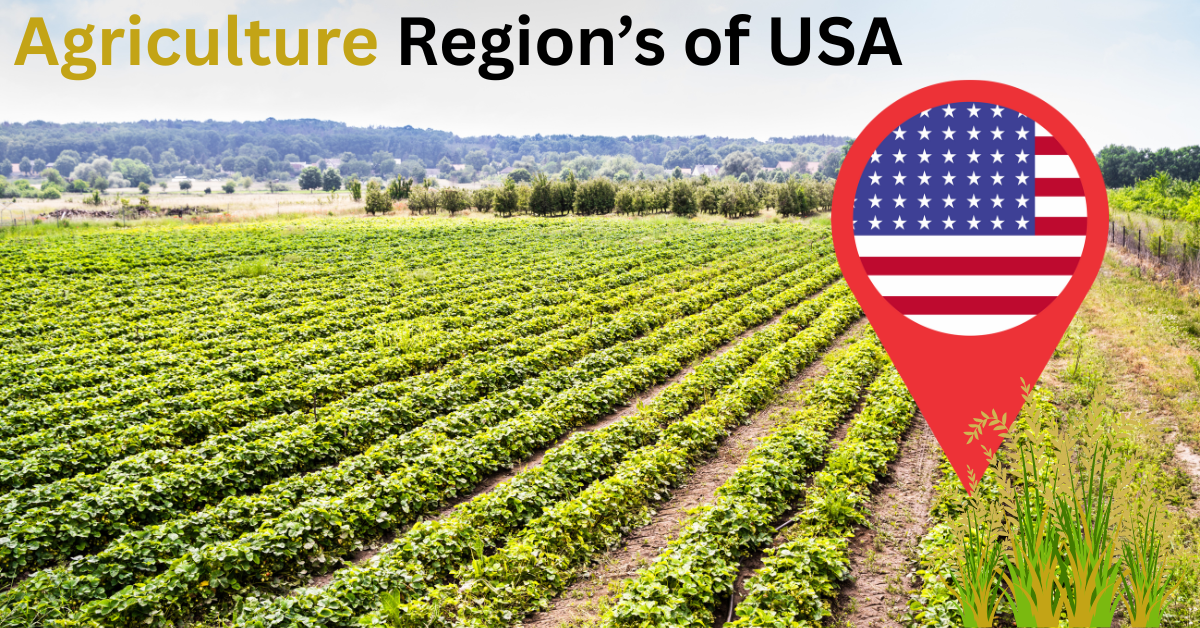Exploring Agricultural Regions of the United States

Because of its expansive terrain, numerous temperature zones, and modern farming methods, the US is one of the world’s top producers of agricultural products. Each of the state’s primary agricultural areas—from the citrus groves of Florida to the wealthy plains of the Midwest—has its personal awesome advantages, crop types, and environmental circumstances.
This blog will protect the USA’s number one agricultural regions, the vegetation they specialize in, and the elements that contribute to their agricultural importance. Discuss all the agricultural regions of the USA.
What Are the Agricultural Regions USA?
Agricultural areas are places where special types of crops or livestock are grown depending on factors, including climate, soil quality, and market access. In the United States, these regions are affected by economic requirements, technological progress, and natural geography. Each location affects the total agricultural production of the nation differently.
Breadbasket in the Midwest US:
The Midwest, sometimes referred to as a “grain belt,” is the most prominent agricultural region in the US. The region is dominated by Iowa, Illinois, Indiana, Ohio, and portions of Nebraska.
Big crops:
- Midwest produces over 90% corn (for biofuels and food)
- Soybeans
- Wheat
- dairy and beef farming
- the Midwest is also a leading region for cattle, pigs, and poultry farming.
Soil and climate:
- Fertile loam
- A moderate amount of rain
- Perfect for automated agriculture and row crops
Significance: The area is crucial to both local food production and exports, particularly grain and animal feed.
Southeast-USA’s Agricultural Region:
Livestock and production during hot weather in the South East
The development of animal husbandry and warm weather is the head of prosperity in the southeast, including Florida, Georgia, Alabama, North Carolina, and South Carolina.
Large crops:
- Peanut (the country led by Georgio)
- Cotton
- Smoking of tobacco
- Fruits and vegetables include watermelon, strawberries, oranges, peaches, tomatoes, and squash.
Pets:
- Feather farming is a large industry, especially in Georgia and Arkansas.
Climate:
- Hot, Maggi Summer and Liberal Winter
- Extended development season, subtropical
- The storm that is now happening and the high humidity
The meaning: Due to the long growing season, the southeast contributes to the new return to the United States during the months of cold.
Western USA: Irrigated Agriculture and Special Crops:
Various crops with high value found in the western region are especially made possible by wide watering in California.
Important crops:
- Grapes (used to make alcohol)
- Peanuts with almonds
- Leafed greens and salads
- A strawberry
- Avocado
Climate and characteristics:
- A Mediterranean climate experienced in parts of California.
- Addiction to reservoirs and rivers for water (eg Colorado River)
Meaning: More than 13% of the country’s agricultural value comes from California alone. In addition, the region is dominated by organic farming and food quality food.
The Great Plains, Which are Home to Cattle and Grain:
The Great Plains, which stretch from Texas to North Dakota, are distinguished by their perfect surface, vast stretches of commercial agriculture, and farms.
Big crops:
- Wheat, particularly in Dakota and Kansas
- Barley
- Sadness
Pets:
- Kveglanging is very common, particularly in Oklahoma and Texas.
Climate:
- Semi-arid for a continental environment
- Strong winds and recurring drought
Significance: The area is crucial for exporting to international markets, raising livestock, and producing grains for wholesale.
Climate-specific Agriculture and the Northwest class:
The Pacific Northwest, particularly Washington, Oregon, and Idaho, benefits from a particular microclimate and lower temperatures.
Big crops:
- Apple (the leading producer in Washington)
- Idaho potatoes in particular
- HOPS (used in the making of beer)
- Cherry and pear
Climate:
- Seaside with winter precipitation
- Volcanic soil in numerous locations
Significance: The Northwest is renowned for its superior, climate-sensitive crops as well as its long-lasting and biological methods.
A Factor that Causes Agriculture Regions of USA:
The definition of agricultural sectors is not arbitrary. Their design is influenced by numerous elements:
Factor: Agriculture-related impact
Climate: Forecasting increasing temperatures, precipitation, and weather
Reproduction, drainage, and crop quality of the soil The impact of suitability
Water accessibility: watering is crucial, particularly in the West.
Market accessibility: Closeness to cities, roads, and export hubs
Technology: GPS-based farming practices, biotechnology seeds, and machine use
Top 10 Crop Production USA Zone:
- Grain belt
- Wheat belt
- Rice belt
- Cotton belt
- Fruit and nut belt
- Dairy
- Botanical belt
- Grass and feed region
- Tobacco belt
- Especially crop area
Top Agriculture Regions of the USA:
- Midwest
- Great Plains
- Southeast
- Northeast
- West
- Pacific Northwest
- Southwest
- California Central Valley
USA Agricultural region’s effect on international trade:
In addition to providing the country, the diversity of US agricultural sectors also contributes to global food security. Large-scale fruits, nuts, soybeans, corn, wheat, and corn are sent from the United States to other countries. Each region uses its knowledge to achieve this achievement. For example, California’s Central Valley delivers fresh returns to Europe and Asia, while the grain belt supplies fuel to cattle and global markets. This agricultural force maintains rural jobs, improves the US economy, and helps keep food prices stable globally.
In conclusion
Gaining knowledge of the United States’ agricultural regions can help one better understand the nation’s rural culture, economy, and food system. Every region has a distinct role that is influenced by its resources, climate, and terrain. It is a patchwork of the American agricultural environment and way of life, whether it be Iowa maize, Florida citrus, or California booze.
These places will benefit from agriculture’s development in response to climate change and technological advancements, but their importance rests in feeding the country and the world.


